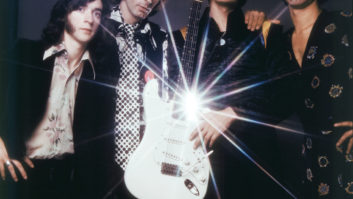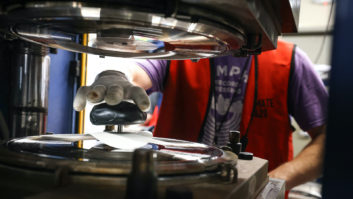
The well-publicized troubles in the music industry have claimed many victims: artists, producers, broadcasters, club owners, publishers, studio owners, etc. Few sectors, however, have been as deeply affected by these uncertain times as the record companies themselves. In the past few years, labels have experienced double-digit declines in CD sales, stiff competition from other forms of entertainment and an adversarial climate in their relationships with artists and the general public.
There is little dissent among record executives about the causes of the industry’s woes. With uncharacteristic unanimity, they all cite piracy — whether in the form of CD burning or file sharing — as the biggest threat they face. Executives also largely concur on their proposed remedies for this bleak situation, though they differ somewhat in their approaches.
The first priority, they say, is to create a legitimate and compelling online music marketplace that attracts a substantial percentage of the audience that is now downloading illegally. Charles Goldstuck, president and COO of the RCA Music Group, says, “We have failed miserably in giving consumers a legitimate alternative for online music, and they have gotten frustrated. They’ve been forced into a position where it’s much easier for them to experience music through a peer-to-peer network than to buy music through legitimate channels. We have to create a viable, legitimate music-distribution environment.”
Val Azzoli, co-chairman and co-CEO of The Atlantic Group, agrees. “The obvious answer,” he says, “is to curtail or stop illegal downloading. That’s the silver bullet. We, as an industry, need to give consumers a secure, safe haven to download as many songs as they want — for a price. Downloading right now is hurting us, but in the end, it will save us.”
The “legitimate” and “secure” systems that Goldstuck and Azzoli describe have existed for more than a year, but their initial incarnations have been widely criticized as overpriced, cumbersome and paltry in their repertoire offerings. However, in the first few months of 2003, major label-run systems such as pressplay (owned by Univeral Music Group and Sony Music Entertainment) and MusicNet (a joint venture between AOL’s Warner Music Group, BMG Entertainment, EMI Recorded Music and Real Networks) have vastly increased their catalogs, and new systems like Listen.com’s Rhapsody and Full Audio’s MusicNow have debuted to generally favorable reactions.
GOING ONLINE
The services vary widely in terms of their specifics, but they generally offer a subscription on the order of $10 per month for streaming and approximately 99 cents per downloaded track. Some services, like pressplay, allow downloads to be burned on CDs, whereas others permit only “tethered” downloads — i.e., ones that will work on the user’s hard drive but cannot be transported to another device.
While early versions of the label-operated online music systems were limited to portions of those companies’ recorded catalogs, new licensing agreements opened up a pool of approximately 250,000 tracks to all the major services, thereby leveling the playing field.
No one is pretending that these label-operated online systems, even in their “new-and-improved” versions, will solve all of the industry’s woes. After all, as Motown president and CEO Kedar Massenburg says, “I’m not competing with Columbia or Arista; I’m competing with free.” Nevertheless, the moves represent a step in the right direction. “The investments are starting to happen to create a more sophisticated, legitimate music listening environment,” says Goldstuck.
KEEPING PRICES DOWN
The key to the industry’s success in re-educating the mass public to pay for music is keeping prices down, not only in its online offerings but in the brick-and-mortar world, as well. In fact, many executives admit that the perceived high price of CDs was the most significant factor in disenfranchising consumers and driving them to free peer-to-peer networks like the now-defunct Napster and newer services like KaZaA, Gnutella and Morpheus.
“Somehow, we have allowed consumer behavior to reach a point where copyright laws are being flaunted and violated, but again, we’re not giving them alternatives,” says Goldstuck. “We may have to relook at pricing structures for music. People say, ‘How can your music be priced higher than DVDs?’ In my opinion, if you have something hot, price it more; otherwise, price it less. At $17.99, there are certainly CDs that are great value and things that are not.”
If lowering the price of CDs would yield a better bang for the consumer buck, then delivering value-added product at full price would serve a similar purpose. Danny Goldberg, chairman and CEO of New York-based independent Artemis Records, says, “Labels have to add value to the product. The movie business has done a brilliant job giving added value to DVDs by including directors’ commentary, bloopers, cut scenes, etc., so people went from renting videotapes to buying DVDs. They want to own the product.
“Experiments with combining DVDs and audio are a clue for the music business,” he continues. “If there was a 50 Cent [the rapper] product that also had a video on it, as much as it’s selling, it would sell millions more.”
Along with the need to keep prices down and add value by bundling DVDs and unique content with CD releases, the music industry is intent on implementing copy protection for CDs, if not as a panacea, then at least as a deterrent to wholesale CD copying.
Citing the alarming statistic that sales of blank CDs outpaced sales of prerecorded CDs for the first time last year, Goldstuck says, “It’s a clear indication that it’s easier for consumers to burn discs than buy [prerecorded] discs. When you can buy 100 blank discs for $19.95 and you have a CD burner at home, it’s a real incentive for you to save $15 and not buy records. That’s as clear evidence as you’re ever going to find that the CD burning phenomenon has reached epidemic proportions. This is not about fair use — people making copies for themselves. It’s people making copies for friends. It’s not cool to buy music anymore.”
Accordingly, says Goldstuck, “Copy protection has to be put in place as a deterrent in the short term, to create road bumps so it’s not as easy to copy CDs at random.”
Others agree. Goldberg says, “If you can make it a little harder to copy, the vast majority of people won’t have the time or the patience to do it.”
At the same time, executives realize that no amount of copy protection will wipe out file sharing or CD cloning. Even if the music, computer and electronics hardware industries could implement an ironclad protection system — a prospect that’s doubtful at best — the resulting climate would be detrimental to free commerce, according to Goldberg.
“I don’t support an obsession with copyright laws to the exclusion of positive marketing ideas and added-value ideas,” he says. “Even if you win every legal battle — and it’s likely that the labels will win every legal battle — you end up with a prohibition type of situation. If you spend all your time with sticks and no time with carrots, that doesn’t work in the entertainment industry.”
CAN’T WE ALL GET ALONG?
While labels grapple with high-tech solutions to their business problems, they are also increasingly turning their attention to improving relations with their artists and, by extension, the general public.
“Now more than ever, artists and record companies really have to become partners,” says Azzoli. “We’re all in this together.”
“We need to change some of the chemistry of those relationships,” adds Goldberg, “so it’s a team effort to try to create success as opposed to a love/hate relationship. That’s an unrealistic and idealistic thing to expect to happen, but it’s a goal. If there could be a little more of that atmosphere, the money that is spent could be focused in a productive way.”
The evolution in the relationship between record companies and artists should include a new vision of the role of the label, according to Goldberg. “We have to create a culture where artists don’t look at the labels as parents or banks, but as service providers,” he says. “We can have economic relationships with artists, but we can’t be the address where every single dream comes true and every investment is made. Labels have to earn that by handling their economics in ways that are minimally more transparent. We can’t magically make something profitable just because an artist thinks it should be profitable, but we can make the accounting more transparent.”
Azzoli says he often advises new artists to think in the long term rather than get blinded by promises of big payments upfront. “I say to artists, ‘You have a record deal, hallelujah! Now let’s write a three-year game plan. We’ll go into the studio for two months to make our album, then we’re going to go on tour, then we’ll take two weeks off in August.’”
“When I started as a manager with Rush,” continues Azzoli, “we toured 10 months of the year, made an album, then went back on the road. We had a two-week vacation in August, and then it was back to work. What I say to young bands is, ‘You have a five-year window. Man, get married at year six! You can’t afford to lose momentum.’”
Azzoli blames some of the industry’s troubles on frivolous spending, which he says occurs at the hands of all parties: labels, radio and artists themselves. “What we have to do is pretend that the ’90s never existed and we have to go back to 1974 or 1984 from an operational point of view,” he says. “The amount of money that’s being wasted in the music industry is unbelievable. It’s wasted on frivolous things like, is it important to spend $250,000 on an album cover? At the end of the day, I don’t think so. The artist will say that it’s part of artist development, but before, they didn’t have to have a choice. Is an album cover as imporant as it used to be? No. Before, all the information about a band was on the album cover. Now you go to www.band.com and you have all the information you need.”
A&R P’S AND Q’S
As labels and artists rethink their relationship with each other, the A&R roles of majors and independents will probably remain as polarized as they have been, according to industry sources.
“Smaller labels have a tendency to sign what they love all the time,” says Goldstuck. “When you look at majors, it’s still a business. The Donnas have had a lot of success, so now the rock/punk girl-band thing is back where all labels are looking for that type of act; the same thing happened with Alanis Morissette. It’s understandable. Every label has to break a certain number of artists, and it’s easier to go with the popular trend.”
Perhaps the biggest factor in the majors’ conservative A&R approach is corporate consolidation. Since the mid-’90s, every major record company has been owned by a conglomerate with interests in the consumer electronics and media industries. To their parent companies, the music divisions are a small and cryptic piece of an increasingly complex puzzle.
“When you involve Wall Street and when you involve people who are not artist development-friendly, it stifles creativity to a certain extent,” says Motown’s Massenburg. “That’s the downside. But on the other side of it, being a business man, it makes you come up with ideas to be creative and more budget-conscious.”
Does the majors’ focus on proven trends present an opportunity for independents to seek and promote cutting-edge acts?
“We haven’t really been actively signing artists who have been disenfranchised from major labels,” says Dan Storper, CEO of Putumayo World Music, a label that specializes in compilations but has also signed its share of artists in recent years, including Miriam Makeba, Oliver Mtukudzi and Mariana Montalvo. “However,I do think independents can be effective at building an artist’s career through developing creative marketing and promotion plans, which often are under the radar of the major media but can be very effective. We continue to believe in the importance of ‘tastemaking,’ i.e., getting CDs to be played in cafes, restaurants, boutiques, etc.”
Goldberg, who prior to launching Artemis held senior-management positions at Atlantic, Warner Bros. and Mercury, says, “Most artists who are unhappy with the majors are unhappy because they’re not getting the attention they feel they deserve. What we can offer is a culture where people who are marginal at majors are superstars for us. That’s historically what independents offer and what they offer today.”
Major or independent, labels have plenty of talent to choose from, according to executives interviewed for this story, who cite the 2003 Grammy® Awards ceremony as evidence of the quality and diversity of today’s music.
“When you look at this year’s Grammys, there was a tremendous amount of talent on display,” says Goldstuck. “There’s nothing wrong with the creativity coming out of the music industry. From a creative standpoint, the industry’s as healthy as it’s been.”
“Listen to India.Arie, Norah Jones or John Mayer,” says Massenburg. “Everything is cyclical, and people are looking for real music from real artists. You’re hearing a lot of organic, soulful music these days.”
LET’S GET SMALL
While every record company, big and small, continues to seek ways to maximize its business, some executives advocate a realignment of expectations. “The industry’s shrinking and we’re all panicking,” says Azzoli. “Like everything else, the key to success is not to panic. Yes, it’s shrinking, but it’s not going to shrink out of existence.”
Goldberg adds, “Everybody has to become more willing to make money on success rather than getting paid in advance. That includes executives who got used to higher salaries than may be possible and artists who got used to higher advances than may be reasonable. The marketing expectations have to conform to the realities of the business. We all have to accept the fact that it’s a smaller business, and if we have any sense about us, we should thank God that we get paid for listening to music.”







